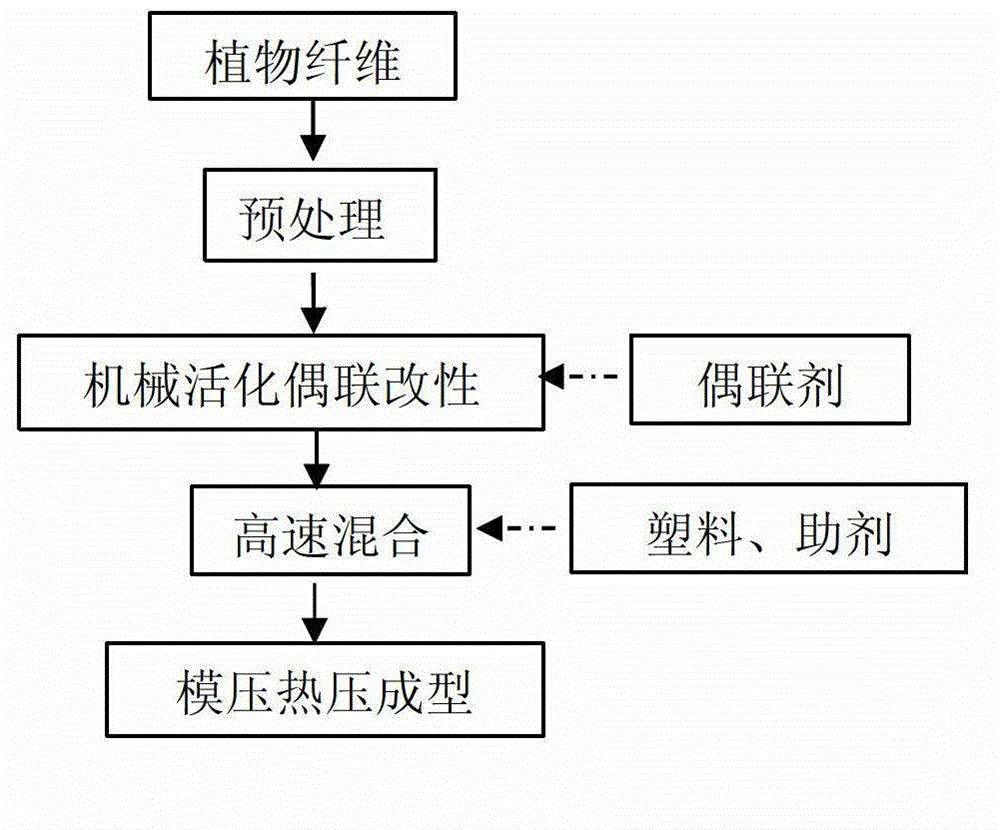Plant fiber wood-plastic composite material and preparation method thereof
A wood-plastic composite material and plant fiber technology, which is applied in the field of plant fiber wood-plastic composite material and its preparation, can solve the problems of high equipment cost, environmental pollution, complicated steps, etc., and achieves enhanced response ability, simplified step process, and improved interface. Compatibility effect
- Summary
- Abstract
- Description
- Claims
- Application Information
AI Technical Summary
Problems solved by technology
Method used
Image
Examples
Embodiment 1
[0034] Select 1000g of cassava distiller's grains, dry them at 100-120 degrees Celsius for 100-120 minutes to make their water content 7%, and crush them to 150-180 mesh. Mix the pulverized cassava distiller's grains and the grinding ball medium according to the ratio of 100g:500ml, at a speed of 700~900rpm, at a temperature of 55 degrees Celsius, stir for 70~90min, add 2% calcium carbonate, and stir evenly. While stirring, use the heat generated by the system itself to raise the temperature to 80 degrees Celsius, then add 55 g of aluminate coupling agent and continue stirring for 10-50 minutes, and discharge to obtain modified cassava distiller's grains.
[0035] The modified cassava distiller's grains obtained above, plastic PVC, silicone oil, diethylenetriamine, butyltin mercaptide, and stearic acid are mixed in a mixing machine at a speed of 6000~ Mix at 7000rpm for 20-30min to obtain the mixed material.
[0036] Put the mixed material obtained above into the mold, raise ...
Embodiment 2
[0038] Select 1000g of cassava distiller's grains and bagasse mixture, dry it at 100-120 degrees Celsius for 70-90 minutes to make its water content 8%, and crush it to 90-120 mesh. Mix the pulverized mixture and the grinding ball medium according to the ratio of 100g:900ml, at a speed of 300~500rpm, at a temperature of 50 degrees Celsius, after stirring for 100~120min, add 8% calcium carbonate, and stir evenly. In the case of stirring, use the heat generated by the system itself to raise the temperature to 85 degrees Celsius, add 35g of titanate and aluminate mixed coupling agent and continue stirring for 25-35min, and discharge to obtain modified plant fibers.
[0039] The modified plant fiber, plastic PVC, paraffin wax, rosin, di-n-tin laurate, and chlorinated paraffin obtained above are mixed according to the mass ratio of 47.5:47:1:2:1.5:1 in a mixing machine at a speed of 5000~5500rpm Mix for 35~45 minutes to get the mixed material.
[0040] Put the mixed material obtai...
Embodiment 3
[0042] Select 1000g of bagasse, dry it at 100-120 degrees Celsius for 110-130 minutes to make its water content 6%, and crush it to 120-150 mesh. Mix the pulverized bagasse and the grinding ball medium according to the ratio of 100g:600ml, at a speed of 250~300rpm, at a temperature of 60 degrees Celsius, after stirring for 50~70min, add 5% calcium carbonate, and stir evenly. In the case of stirring, use the heat generated by the system itself to raise the temperature to 80 degrees Celsius, then add 60 g of aluminate coupling agent and continue stirring for 10-50 minutes, and discharge to obtain modified bagasse.
[0043] The modified bagasse obtained above, plastic PVC and PE mixture, butyl stearate and silicone oil mixture, 1,2-hydroxystearic acid, mercaptan octyl ester, and zinc stearate were mixed in a mass ratio of 50:43.7 : 3: 0.8: 1: 1.5 Mix in a mixing machine for 50-60 minutes at a speed of 7000 rpm to obtain a mixed material.
[0044] Put the mixed material obtained ...
PUM
| Property | Measurement | Unit |
|---|---|---|
| density | aaaaa | aaaaa |
| density | aaaaa | aaaaa |
| Brinell hardness | aaaaa | aaaaa |
Abstract
Description
Claims
Application Information
 Login to View More
Login to View More - R&D
- Intellectual Property
- Life Sciences
- Materials
- Tech Scout
- Unparalleled Data Quality
- Higher Quality Content
- 60% Fewer Hallucinations
Browse by: Latest US Patents, China's latest patents, Technical Efficacy Thesaurus, Application Domain, Technology Topic, Popular Technical Reports.
© 2025 PatSnap. All rights reserved.Legal|Privacy policy|Modern Slavery Act Transparency Statement|Sitemap|About US| Contact US: help@patsnap.com

